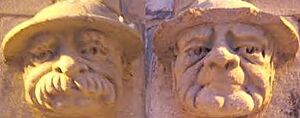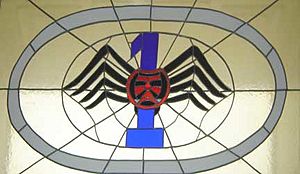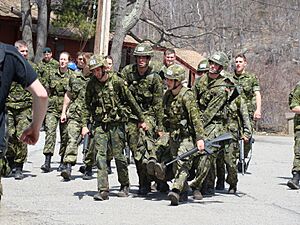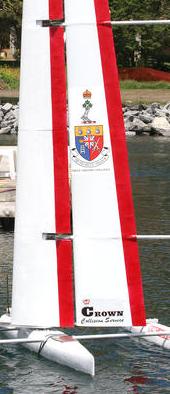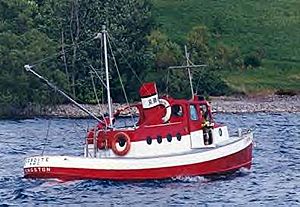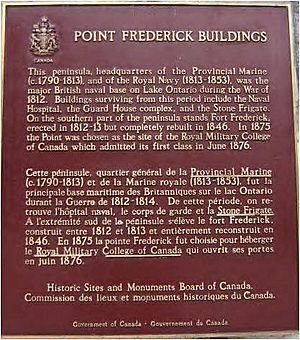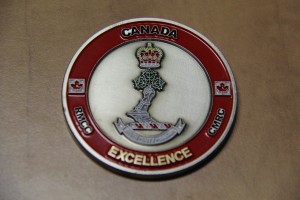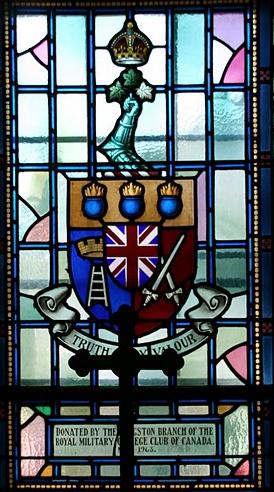Royal Military College of Canada facts for kids
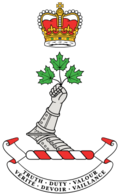 |
|
| Motto | Truth, Duty, Valour (Verité, Devoir, Vaillance) |
|---|---|
| Type | Military academy |
| Established | 1876 |
|
Academic affiliations
|
|
| Chancellor | David McGuinty (ex officio as Defence Minister) |
| Principal | Jill Scott |
| Commandant | BGen Pascal Godbout |
|
Administrative staff
|
200 |
| Undergraduates | 1,160 full-time; 990 part-time |
| Postgraduates | 300 full-time |
| Location |
Kingston, Ontario, Canada
44°13′44″N 76°28′07″W / 44.22889°N 76.46861°W |
| Campus | 41-hectare peninsula east of downtown Kingston (Point Frederick); Waterfront CFB Kingston |
| Language | English, French |
| Call signs | VE3RMC; VE3RMC-9; VE3RMC-11 |
| Colours | |
| Nickname | RMC Paladins |
|
Sporting affiliations
|
U Sports – OUA MAISA |
| Mascot | Paladin in scarlet uniform with shield (2009) |
 |
|
The Royal Military College of Canada (RMC), also known as Collège militaire royal du Canada (CMR) in French, is a special university for the Canadian Armed Forces. It's a military academy that has been able to grant university degrees since 1959.
RMC first opened its doors on June 1, 1876. It offers programs for both new students (undergraduate) and those continuing their studies (graduate). You can study on campus or through their distance learning program.
The college is located on Point Frederick, a 41-hectare (about 100-acre) piece of land in Kingston, Ontario. It has a mix of old, historic buildings and newer ones for classes, sports, and dorms. Students at RMC, called officer cadets, are trained in four main areas: academics (schoolwork), officership (leadership skills), athletics (sports), and bilingualism (speaking both English and French).
Contents
What is the Purpose of RMC?
The Royal Military College of Canada prepares officer cadets for a long career as military leaders. It also helps other Canadian Armed Forces members and civilians who are interested in defence topics. RMC provides higher education and special training to meet the needs of the Canadian Armed Forces and the Department of National Defence.
RMC's main goals are to:
- Offer university education in both English and French. These programs are designed to meet the unique needs of the Canadian Armed Forces.
- Help officer cadets develop strong leadership skills.
- Ensure officer cadets can communicate well in both English and French.
- Help students achieve a high level of physical fitness.
- Teach students about the important values of the military profession.
- Conduct research that supports RMC and the needs of defence research groups.
RMC also focuses on:
- Creating excellent, world-class programs important to the Canadian Armed Forces and Canada.
- Encouraging teamwork and partnerships with other groups in Canada and around the world.
- Promoting cooperation between different study areas.
History of the College
How RMC Started
Even before RMC opened in 1876, people in Canada wanted to create military colleges. In 1874, a law was passed to create a military college that would teach about military tactics, engineering, and general science needed for the military.
The new college, first called the Military College of Canada, opened on June 1, 1876. It had 18 cadets, who are still remembered today as the "Old Eighteen." In 1878, Queen Victoria allowed the college to use the name "Royal," so it became the Royal Military College of Canada. It was the first military college in a British colony.
Unlike British military schools, RMC offered a four-year program focused on science and engineering. Not all graduates had to become full-time army officers. Many cadets went on to civilian jobs, and some joined the part-time Canadian Militia.
At first, there were very few French-speaking cadets because the entrance exams were in English. In the early 1890s, the college improved under Superintendent Gerald Kitson, who made the course three years long. After 1910, all cadets had to attend a militia camp and join either the permanent military or the militia after graduating.
RMC During the World Wars
During the First World War, RMC stayed open, but the course was shortened to two years. Many former cadets (982 of them!) served in the war, and they held many important leadership roles.
After the war, RMC went back to its four-year program. During the Great Depression in the 1930s, unemployed men helped with construction projects at the college, like rebuilding the wall around Fort Frederick.
In 1942, RMC stopped training cadets for the rest of World War II. Instead, it became a training facility for wartime courses. Again, many eligible cadets fought in the war and became senior leaders in the Canadian Army.
From 1945 to Today
After World War II, there was a debate about whether RMC should reopen. But in 1948, it did reopen as a college for all three military services (Army, Navy, Air Force) with the "New One Hundred" cadets.
In 1959, RMC became the first military college in the British Commonwealth to be able to grant its own university degrees. Before this, cadets had to go to a civilian university for their final year to get a degree. Desmond Morton was the first RMC graduate to receive a degree directly from the college in 1959.
In 1969, RMC became bilingual, meaning it offered education in both English and French. In 1979, women were first admitted to military colleges as officer cadets and graduate students. The first 32 female cadets joined RMC in September 1980.
In 1976, RMC celebrated its 100th anniversary. The cadets even paraded on Parliament Hill in Ottawa.
Here are some other important moments in RMC's history:
- 1878: The officer cadet uniform became mostly the same as it is today.
- 1883: RMC started giving out diplomas instead of just certificates.
- 1883–84: The first recorded First Aid class in Ontario was held at RMC.
- 1886: The first recorded hockey game between Queen's University and RMC students was played.
- 1906: The tradition of the "roll call" began, which is still done today.
- 1915: Many men took a tough exam for the few spots at RMC during the First World War.
- 1919: The Prince of Wales presented RMC with its official colours (flags).
- 1948: RMC, along with Royal Roads Military College and Le Collège militaire royal de Saint-Jean, formed the Canadian Military Colleges Circle.
- 1953: The RMC Band was founded, including pipes and drums, brass and reeds, a choir, and highland dancers.
- 1964: The RMC College Flag helped inspire the design of the Canadian flag.
- 1976: RMC had its largest graduating class ever, with 200 cadets.
- 1985: RMC started operating a small research nuclear reactor.
- 1993: A special ceremony was held to give degrees to all who graduated from RMC before it could grant its own degrees.
- 1997: The RMC Board of Governors was created to advise the Minister of National Defence.
- 2001: The Royal Canadian Mint issued a 5-cent coin to celebrate RMC's 125th anniversary.
- 2008: RMC launched the Aboriginal Leadership Opportunity Year (ALOY) program.
- 2010: RMC started allowing foreign military officers to study there.
- 2013–14: RMC began admitting civilian students under Project Hero, a scholarship for children of Canadian Forces personnel who died on duty.
How RMC is Organized
RMC's main goal is to educate, train, and develop officer cadets to become leaders in the Royal Canadian Air Force, the Royal Canadian Navy, and the Canadian Army.
For most students in the Regular Officer Training Plan (ROTP), their education is free. They also receive a monthly salary to cover their expenses. Courses are taught both on campus and online, in English and French. After graduating, officers agree to serve in the Canadian Forces for a certain period.
RMC offers 19 undergraduate programs in areas like Social Sciences, Humanities, Science, and Engineering. It also has 34 graduate programs, including 14 doctorates. The Division of Continuing Studies offers programs for ongoing learning, including the "Officer Professional Military Education" program.
All undergraduate students must complete a core curriculum. This includes subjects like Economics, Psychology, Mathematics, English, Calculus, Military history of Canada, Chemistry, Canadian History, Physics, and Civics.
| Faculty of Engineering | Faculty of Social Sciences and Humanities | Faculty of Science |
|---|---|---|
|
|
|
| Applied Military Science | Faculty of Continuing Studies | |
|
|
Research and Special Centres
Research at RMC mostly focuses on topics that help the Department of National Defence. Over 90% of the research is related to defence. This includes studies in engineering, physics, chemistry, and international security. Both military members and civilian students can join master's and doctoral programs, and funding is available to support them.
Some of the special centres and institutes at RMC include:
- Canadian Forces Language School: Teaches cadets how to speak both English and French.
- Canadian Forces Leadership Institute (CFLI): Teaches about leadership and command, and conducts research on leadership in the armed forces.
- Centre for Space Research: Promotes space research and supports space-related degree programs.
- Centre for Manufacturing of Advanced Ceramics and Nanomaterials: Supports research and education in advanced materials.
- Fuel Cell Research Centre: Works to improve fuel cell technology.
- GeoEngineering Centre: Focuses on engineering related to the Earth's materials.
- Institute for Defence Resources Management: Studies defence economics to help Canadian defence policy.
- Defence and Security Research Institute (DSRI): A centre for defence and security research.
- Canadian Institute for Military and Veteran Health Research (CIMVHR): Studies health issues for military members and veterans.
- Centre for Security, Armed Forces and Society (CSAFS): A think tank that researches political and strategic topics for defence clients.
Military Law
The Military Law Centre at RMC teaches officers and troops about legal matters. This includes the military's own rules and the laws of war. It also trains military lawyers and advises the government on military policy. RMC cadets also take part in international competitions on the Law of Armed Conflict.
Research and Partnerships
RMC works on research in many areas. In engineering and science, they focus on:
- Information technology and communications
- The environment
- energy and its development
- Advanced materials engineering
- geotechnical engineering (study of earth materials)
- fluid mechanics
In social sciences and humanities, research includes:
- military history
- political science and international security
- peacekeeping
- international relations and ethics in conflict
- leadership
- economics
The Department of Applied Military Science offers programs for captains, majors, and warrant officers.
RMC also offers an online program called the Diploma in Military Arts and Sciences (DMASc) for non-commissioned members of the Canadian Forces. Graduates of this program can continue their studies at RMC for a Bachelor's degree.
The college is also part of the University of the Arctic, a network of universities that promotes education and research in the Arctic region.
How to Get In
Training Plans
There are a few ways to get an education at RMC:
Regular Officer Training Plan (ROTP)
The Regular Officer Training Plan (ROTP) is like a scholarship. If you are chosen, you get a university education, military training, and language training. You also get a job after you graduate. You receive a full-time salary, dental care, and paid vacation. After you finish ROTP, you get a university degree and become an officer in the Canadian Forces. Usually, you agree to serve at least five years in the Canadian Forces.
Most successful applicants go to a Canadian Military College (CMC) like RMC. Here, they get an education that balances schoolwork, leadership, bilingualism, and sports. If your chosen program (like Nursing) isn't offered at RMC, or if you want to go to another university, ROTP can still cover your books, lab fees, and student fees at any Canadian university, and you'll still get a monthly salary.
Other Programs
- UTPNCM: This is for non-commissioned members of the Canadian Forces who want to earn a degree and become officers.
- IBDP: The Initial Baccalaureate Degree Program is a bachelor's degree program.
- DCS: The Division of Continuing Studies offers part-time programs.
How Students are Chosen
To apply for ROTP, you also apply to the Canadian Military College System. All candidates take an aptitude test, a medical examination, and have an interview.
Your military potential is judged based on your skills, personality, and job choice. Your school grades are also very important, from grade 9 to your final year. Officer cadets must keep up good grades and military performance throughout the program.
Continuing Studies
RMC started its graduate studies program in 1965. The Division of Continuing Studies was created in 1997.
This division helps all members of the Canadian Forces, their spouses, and civilian employees of the Department of National Defence get a university education. Military training can count as credit towards a degree.
Special degree programs for Canadian Forces members include:
- Bachelor of Military Arts & Sciences
- Master of Business Administration
- Master of Defence Management and Policy
- Master of Arts and PhD in War Studies
Tuition Fees
For the 2022–23 school year, tuition fees for Canadian undergraduate students were about $3,020 to $4,140 per term. For Canadian graduate students, it was about $2,670 to $2,980 per term. International students paid more. Arts and science programs were less expensive than engineering programs.
However, for most on-campus undergraduate officer cadets, education is free because they commit to military service after graduation. They also get a monthly salary. Civilian students in master's and doctoral programs can also get funding to study alongside military students.
Life as a Cadet
Uniforms
Cadets wear different uniforms for different events. These include ceremonial uniforms, formal uniforms, sports clothes, and combat uniforms. Since 2009, RMC cadets have worn a special daily uniform with a white shirt, black sweater, and black pants with a red stripe. For formal events, they wear a dark blue uniform with a red stripe.
Student Life

- The RMC Cadet Mess in Yeo Hall is a place for social activities and fun.
- The Baronial Hall, or Currie Hall, is an important building used for special events, speeches, and conferences.
- The CANEX is a small store in Yeo Hall where cadets can buy snacks, souvenirs, and personal items.
- Bill & Alphie's, the cadet mess, is named after cartoon characters from World War I. Stone carvings of these characters are at the entrance to Yeo Hall.
- The campus is right on Lake Ontario, close to parks and downtown Kingston.
- Cadets are expected to help the community. Each year, different classes work on projects like helping underprivileged youth, collecting food for food banks, or cleaning city parks.
- RMC has many student clubs, including Arts, Astronomy, Broomball, Cheerleading, Chess, Climbing, Cycling, Debating, drama, golf, Judo, Juggling, Taekwondo, Outdoors, Paintball, Photo, rowing, Social Dance, Stage Band, Triathlon/Running, Video Editing, War Games, Water Polo, Windsurfing, Women's Rugby, and Yachting. An Automotive Club was recently added.
Cadet Squadrons
The undergraduate students are called the Cadet Wing. They are divided into 13 squadrons, each with about 80 cadets. Each squadron has three flights, and each flight has three sections. Senior cadets lead the squadrons, guided by a squadron commander.
| Squadron # | Name | Mascot |
|---|---|---|
| 1 | Hudson | Spider |
| 2 | La Salle | Gryphon |
| 3 | Pontiac | Grizzly Bear |
| 4 | Frontenac | Shark |
| 5 | Brock | Phoenix |
| 6 | Brant | Pirate |
| 7 | Wolfe | Wolf |
| 8 | Mackenzie | Bulldog |
| 9 | Verchères | Tiger |
| 10 | Montcalm | Dragon |
| 11 | Cartier | Beaver |
| 12 | Fraser | Deer |
RMC Bands
The Massed Band includes the Brass and Reed, Pipes and Drums, and Highland Dancers. They perform at parades and public events. The Brass and Reed Band plays for parades and concerts. The Pipe Section and Drum Section perform at dinners, parades, and ceremonies. The Highland Dance Section performs at many of these events too. The Choir sings the Canadian national anthem and performs with the Stage Band. The Stage Band plays dinner music and marches. The Cheer Band plays music for RMC sports events.
Athletics and Sports
Sports are a very important part of life at RMC. The athletic program helps officer cadets stay fit, build confidence, and develop leadership skills. Physical education aims to teach strong skills in fitness, sports, and military activities. Cadets must take physical education classes and play intramural sports every year, for at least four hours a week. This helps them stay fit and develop the skills needed to lead their troops.
Military Training
Military training at RMC starts with Basic Military Officer Qualification (BMOQ) in the summer before first year. This training happens at the Canadian Forces Leadership and Recruit School Saint-Jean. After BMOQ, cadets who are not yet bilingual usually take a seven-week Second Language Training (SLT) course. Other summers are spent doing different types of training depending on each cadet's specific military branch or job.
First Year Orientation Period (FYOP)
The First Year Orientation Period (FYOP) is a very challenging time for new cadets. It lasts for the first month of the school year, after they finish the first part of BMOQ. During FYOP, first-year cadets must keep their uniforms and rooms very neat. They must march everywhere. They do a lot of physical training, including long runs up Fort Henry, Ontario hill. Their rooms and uniforms are inspected daily. During FYOP, first-year cadets cannot leave RMC or have visitors. Mail and phone calls are limited.
FYOP ends with an obstacle course. This course lasts over two hours and has twelve obstacles built by each squadron. Obstacles like a 12-foot wall and a rope bridge test teamwork and physical fitness. Completing the obstacle course means FYOP is over. Afterward, first-year cadets have a parade where they are officially welcomed into RMC and join the Cadet Wing. They can then see their friends and family and leave college grounds.
Second-year cadets act as "academic parents" to first-year cadets. They help guide and mentor them during their studies.
Campus and Buildings
RMC is located on Point Frederick in Kingston, Ontario. This small piece of land is where the St. Lawrence River meets Lake Ontario and where the Rideau Canal begins. This area has been a military base since 1789.
Point Frederick includes two sites that are National Historic Sites of Canada: the Royal Navy Dockyard and the Point Frederick Buildings.
The Stone Frigate, a large stone building finished in 1820, was originally built to store equipment for British warships. It was later turned into a dormitory and classrooms for RMC by 1876.
During the Great Depression in Canada in the 1930s, unemployed men helped with construction projects at RMC. They rebuilt the wall and moat of Fort Frederick, extended the physics building, and built new sports fields. Yeo Hall, a mess building, was opened in 1936.
The Officers' Mess moved in 1960, and 'Bill & Alfie's' became a fun place for senior cadets. Dormitories and Yeo Hall were renovated between 1993 and 1995. In 1997, the dining room and kitchen were expanded.
Both Royal Military College of Canada chapels for Roman Catholic, Protestant, and Muslim communities are located in Yeo Hall.
Important Buildings
The RMC campus has many historic buildings. Some of the important ones include:
- Hewett House (1875-1876): Designed by Thomas Seaton Scott.
- Commandant's Residence (1813-1814): A former Royal Navy Hospital.
- Currie Building (1918-1920): Honors Lieutenant-General Sir Arthur Currie.
- Mackenzie Building (1876-1878): A very important building on campus.
- Stone Frigate (1819-1824): The oldest dormitory.
- Panet House (1903): Designed in the Scottish Baronial style.
- Fort Frederick Martello Tower (1846-1847): A historic tower that now houses the RMC Museum.
- Memorial Arch (1923): Built to remember cadets who died in World War I.
- Yeo Hall (1935): A mess building named after Sir James Lucas Yeo.
- Fort Lasalle Dormitory (1912): Another dormitory building.
- Fort Champlain Cadet Dormitory (1965): A more modern dormitory.
- Old Gymnasium (1900-1903): An older gym building.
- Administration Building (1887): A former hospital now used for administration.
Other Campus Buildings
| Building (built) | Recognition | Image |
|---|---|---|
| Sawyer building (1977) | Engineering building, honors Col WR Sawyer. |  |
| Senior Staff Mess (1960–1962) | Features paintings donated by former cadets. | |
| Massey Library (1960) | Honors Rt Hon Vincent Massey. |  |
| Fort Sauvé Dormitory Building (2001) | Honors Rt Hon Jeanne Sauvé. |  |
| Fort Brant Dormitory Building (2010) | Honors Chief Joseph Brant. |  |
Libraries
The Royal Military College of Canada Libraries has about 250,000 books and many other items in both English and French. It also has historical materials about RMC, like cadet photographs and diaries.
Some important collections include:
- Leadership Collection: Donated by the class of 1956.
- John W. Spurr Collection: Focuses on Military science.
- General Harry Crerar Collection: Includes German military manuals from World War II.
Dormitories
RMC has six dormitories, which are like student housing at other universities. They are co-educational, meaning both male and female cadets live there, with separate washrooms. First-year officer cadets often share a room, sometimes with someone who speaks the other official language.
The oldest dormitory is the Stone Frigate, built in 1819–20. It is a Canadian Heritage Site. Other dorms include Fort Lasalle, Fort Haldimand, Fort Champlain, Fort Sauve, and the newest, Fort Brant.
Honorary Degrees
RMC can give out honorary degrees to people who have made important contributions. Nominations can come from different groups or individuals. The college senate, which includes the Chancellor (the Minister of National Defence) and other leaders, makes the final decision.
Alumni
The RMC alumni association, called the RMC Club, started in 1885. It helps former students stay connected.
The Royal Military Colleges of Canada Foundation is a charity that helps RMC financially. It raises money for projects like the Leonard Birchall Pavilion and the Memorial Arch Restoration.
Artist-in-Residence Program
RMC started its Artist-in-Residence program in 2010. This program brings artists like novelists, poets, and playwrights to the college. They work with cadets and share their creative skills. For example, in 2014, Gord Sinclair from The Tragically Hip was the Artist-in-Residence and put on a concert with cadets, staff, and faculty.
Media
RMC used to have a campus newspaper called the Precision. Now, the alumni association publishes Veritas and e-Veritas. There is also a satirical campus newspaper called "The Slasher Standard."
Symbols, Memorials, and Traditions
RMC has many symbols, memorials, and traditions. These include the Triumphal Arch, trophies, memorial trees, and monuments.
For Remembrance Day in 2012, first-year English students wrote poems about people connected to RMC who died serving their country.
RMC's official cheer is:
- Call: Gimme a beer!
- Response: Beer! Esses! Emma! T-D-V!
Who can stop old RMC!
Shrapnel, Cordite, NCT!
R-M-C Hooah!
Heraldry and Coat of Arms
In 1920, King George V officially granted RMC its coat of arms. It features a ladder, a crown, swords, and grenades, with a mailed arm holding maple leaves as the crest. These symbols represent the college's military purpose and connection to Canada.
Motto
RMC's motto is "Truth, Duty, Valour." The first college Commandant, Lieut. Colonel Hewett, announced it in 1878. He said the motto and the college's badge (a mailed arm holding a maple leaf) symbolize what future officers should be: truthful, dedicated to duty, and brave for their country.
Music
The RMC march, Precision, was composed by Madame Denise Chabot, whose husband worked at RMC. She was inspired by the sound of cadets marching. The march begins, "We are the gentlemen cadets of RMC. We have sworn to love and serve Her Majesty…"
The college also has a march for bagpipes called Alexander Mackenzie.
See also
 In Spanish: Escuela Militar de Canadá para niños
In Spanish: Escuela Militar de Canadá para niños
- Royal Military College of Canada Museum
- Royal Military College Saint-Jean
- Royal Roads Military College
- Canadian Military Colleges


